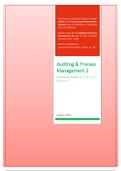Summary
Summary Auditing and Process Management 2 - Chapters 5, 6, 7, 8, 9, 10, 11
- Course
- Institution
- Book
Summaries & Keywords based on the 14th edition of the Accounting and Information Systems book, by Marshall B. Romney & Paul John Steinbart. Initially meant for the Auditing and Proces Management (2) class & exam of Saxion Enschede 2017 – 2018 Exercises available on: wps.pearsoned.com/bp_romne...
[Show more]




